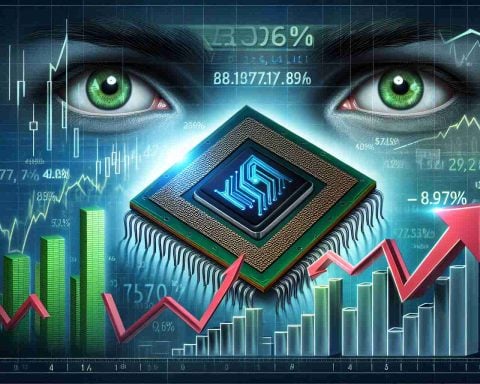- Nvidia has seen a significant stock drop of 15.8% this week, leading to a $600 billion decline in market valuation.
- DeepSeek’s new R1 AI model demonstrates superior performance to OpenAI’s models at a more efficient training cost of under $6 million.
- Geopolitical tensions and fears regarding U.S. AI leadership against China are contributing to market volatility.
- The Federal Reserve’s uncertainty about interest rates further complicates the financial landscape for investors.
- Nvidia’s fourth-quarter results announcement on February 26 may significantly affect its stock performance amid these challenges.
- Continued evolution in AI technology poses new threats and opportunities for Nvidia’s market position.
Nvidia, the titan of graphics processing units (GPUs), has experienced a staggering 15.8% drop in its stock this week, with an earth-shattering $600 billion decline in market valuation. This sudden downturn has left investors on edge as revelations from DeepSeek, a rising AI player, hint at a significant shift in the industry.
The R1 AI model from DeepSeek has emerged as a formidable contender, reportedly outperforming OpenAI’s latest innovations while costing a fraction—under $6 million to train compared to the whopping $100 million for OpenAI’s models. This drastic contrast in efficiency could signal a waning appetite for Nvidia’s cutting-edge GPUs, traditionally the gold standard in AI training and execution.
Moreover, the latest geopolitical tensions surrounding AI advancements add to the stock’s volatility. Fears of the U.S. relinquishing its AI leadership to China, amplified by potential tariffs on Chinese imports, have investors unsettled. Alongside this, the Federal Reserve’s indecisiveness regarding interest rates only adds to the market’s uncertainty.
Despite these challenges, Nvidia maintains a powerful position in the GPU landscape. However, investors should brace for continued fluctuations. Mark your calendars for February 26, when Nvidia is set to unveil its fourth-quarter results, which could act as a pivotal moment for its stock valuation amidst the turbulent waters of AI innovation.
Takeaway: As AI technology continues to evolve rapidly, Nvidia must navigate these emerging threats while leveraging its market strengths to stay ahead.
Unveiling the Future: Nvidia’s Tumultuous Journey Amidst Rising AI Competitors
Nvidia, renowned for its dominance in the graphics processing unit (GPU) market, is navigating through a challenging financial landscape. Following a significant 15.8% decline in its stock value and an astounding $600 billion decrease in market capitalization, concerns about its future have become prominent. The shift in dynamics within the AI space, primarily driven by emerging competitors like DeepSeek, is reshaping investor perspectives and market strategies.
Key Trends and Insights:
– New AI Competitors: The introduction of DeepSeek’s R1 AI model marks a pivotal shift. This model reportedly outperforms OpenAI’s offerings at one-sixtieth of the training cost, raising questions about the continued demand for Nvidia’s GPUs in AI training.
– Geopolitical Factors: The increasing tension between the U.S. and China over AI advancements poses additional risks to Nvidia’s market position. Concerns about losing AI competitiveness to China are leading to investor hesitance, particularly with uncertainties over potential trade tariffs.
– Market Predictions: Analysts speculate that if DeepSeek’s momentum continues, we could see a significant reallocation of resources within the AI development space, potentially diminishing Nvidia’s market share. Investors are keenly awaiting Nvidia’s upcoming fourth-quarter financial results on February 26, which could provide clarity on the company’s strategy and resilience.
Pros and Cons of Nvidia’s Position:
| Pros | Cons |
|—————————————————-|—————————————————|
| Established brand in GPU market | Increased competition from efficient AI models |
| Strong infrastructure and developer support | Geopolitical uncertainties affecting stock prices |
| Innovation in GPU technology for gaming and AI | High operational costs compared to new entrants |
Limitations of Nvidia’s GPUs:
1. High Cost: The training costs for AI models using Nvidia GPUs are significant, limiting accessibility for smaller companies.
2. Dependency on AI Market: As the AI market matures, reliance on Nvidia’s hardware for performance could diminish as alternatives emerge.
3. Environmental Concerns: The production and energy consumption of GPUs raise sustainability questions, which may affect Nvidia’s public perception and market strategies.
Potential Use Cases:
– Gaming: Nvidia continues to serve the gaming industry with high-performance GPUs.
– AI Research: Despite rising competition, Nvidia GPUs remain critical in train large-scale AI models.
– Data Center Solutions: Nvidia is innovating in data processing, asserting its relevance in cloud computing solutions.
Frequently Asked Questions
1. How does the R1 AI model compare to Nvidia’s offerings in terms of performance?
The R1 AI model from DeepSeek reportedly outperforms Nvidia’s GPUs at a dramatically lower cost, suggesting a fundamental shift in efficiency that could impact Nvidia’s share in the AI training market.
2. What impact are geopolitical tensions having on Nvidia’s operations?
The geopolitical landscape, particularly tensions with China and discussions on tariffs, is creating uncertainty that affects Nvidia’s stock performance and investor confidence in the company’s long-term strategy.
3. What should investors watch for in Nvidia’s upcoming earnings report?
Investors should focus on revenue projections, insights regarding AI competition, and strategic initiatives addressing emerging threats in the market during Nvidia’s report on February 26.
For further insights into Nvidia’s future and the broader tech landscape, check here.




















